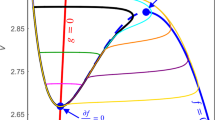Abstract
Excitatory and inhibitory synaptic coupling can have counter-intuitive effects on the synchronization of neuronal firing. While it might appear that excitatory coupling would lead to synchronization, we show that frequently inhibition rather than excitation synchronizes firing. We study two identical neurons described by integrate-and-fire models, general phase-coupled models or the Hodgkin-Huxley model with mutual, non-instantaneous excitatory or inhibitory synapses between them. We find that if the rise time of the synapse is longer than the duration of an action potential, inhibition not excitation leads to synchronized firing.
Similar content being viewed by others
References
Abbott LF (1990) A network of oscillators. J. Phys. A23:3835.
Abbott LF and van Vreeswijk C (1993) Asynchronous states in networks of pulse-coupled oscillators. Phys. Rev. E48L: 1483–1490.
Ermentrout GBJ (1985) Synchronization in a pool of mutually coupled oscillators with random frequencies. Math. Biol. 22:1–9.
Ermentrout GB and Kopell N (1984) Frequency plateaus in a chain of weakly coupled oscillators I. SIAM J. Math. Anal. 15:215–237.
Golomb D, Wang X-J, and Rinzel J (1994) Synchronization properties of spindle oscillations in a thalamic reticular nucleus model, (submitted).
Hansel D, Mato G, and Meunier C (1993) Phase dynamics for weakly coupled Hodgkin-Huxley Neurons. Europhys. Lett. 23:367–372.
Kopell N and Sommers D (1994) Anti-phase solutions in relaxation oscillators coupled through excitatory interactions. J. Math. Biol. (in press).
Kuramoto Y (1984) Chemical Oscillations, Waves and Turbulence (Springer, New York).
Kuramoto Y (1991) Collective synchronization of pulse-coupled oscillators and excitable units. Physica. D50:15–30.
Lytton WW and Sejnowski TJ (1991) Simulations of cortical pyramidal neurons synchronized by inhibitory interneurons. J. Neurophysiol. 66:1059–1079.
Mirollo RE and Strogatz SH (1990) Synchronization of pulsecoupled biological oscillators. SIAM J. Appl. Math. 50:1645–1662.
Peskin CS (1975) Mathematical Aspects of Heart Physiology. Courant Institute of Mathematical Sciences, New York University, New York. pp. 268–278.
Sherman A and Rinzel J (1992). Rhythmogenic effects of weak electronic coupling in neural models. PNAS 89, 2471–2474.
Sorti DW and Rand RH (1986) Dynamics of two strongly couplec relaxation oscillators. SIAM J. Appl. Math. 46:56–67.
Steriade M, McCormick DA, and Sejnowski TJ (1993) Thalamocortical Oscillations in the Sleeping and Aroused Brain. Science 262:679–685.
Wang X-J and Rinzel J (1993) Spindle rhythmicity in the reticularis thalami nucleus: Synchronization among mutually inhibitory neurons. Neurosci. 53:899–904.
Wang X-J and Rinzel J (1992) Alternating and synchronous rhythms in reciprocally inhibitory model neurons. Neural Comp. 4:84–97.
Winfree ATJ (1967) Biological rhythms and the behavior of populations of coupled oscillators. Theor. Biol. 16:15–42.
Author information
Authors and Affiliations
Rights and permissions
About this article
Cite this article
Van Vreeswijk, C., Abbott, L.F. & Bard Ermentrout, G. When inhibition not excitation synchronizes neural firing. J Comput Neurosci 1, 313–321 (1994). https://doi.org/10.1007/BF00961879
Received:
Revised:
Accepted:
Issue Date:
DOI: https://doi.org/10.1007/BF00961879




